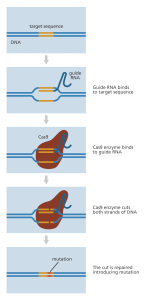Cutting up the genome
Answer: It comes from bacteria and is completely revamping how scientists edit genetic material.
Everyone Should Know This:
 Imagine being able to cut the proteins that cause allergic reactions to humans out of chicken eggs, create mosquitos that cannot carry malaria, or bring back woolly mammoths from extinction. These are all possibilities with the use of a new biological discovery: the CRISPR—Cas9 sequence (Reardon, 2016).
Imagine being able to cut the proteins that cause allergic reactions to humans out of chicken eggs, create mosquitos that cannot carry malaria, or bring back woolly mammoths from extinction. These are all possibilities with the use of a new biological discovery: the CRISPR—Cas9 sequence (Reardon, 2016).
Currently CRISPR—Cas9 is the simplest way to change genetic information by removing, adding, or modifying DNA sequences and it is causing a buzz in the science world. CRISPR and Cas9 have both been talked about in biology circles for around fourteen years now. CRISPR was first discovered during research at the University of Alicante in Spain from 1993 to 2005 and Cas9 was first discovered in 2005 at the French National Institute for Agricultural Research. In 2010 the CRISPR—Cas9 sequence was used together to precisely cut DNA for the first time (“CRISPR Timeline,” n.d.).
But how does CRISPR—Cas9 work? The sequence is like a pair of scissors as it can precisely cut genetic information in any organism (“What Is CRISPR-Cas9?,” 2016). There are two molecules essential to the sequence’s success: Cas9 and guide RNA. Cas9 itself is the scissor that cuts the DNA, but the guide RNA (or gRNA) is a piece of RNA that binds to DNA at the target genomic sequence. Cas9 follows the guide RNA and cuts, adds, or modifies the genes at that specific location (“What Is CRISPR-Cas9?,” 2016).
While the CRISPR—Cas9 gene editing is intuitive, scientists did not artificially create the sequence, but instead it was discovered inside bacteria that used it to fight off viruses and pathogens. These bacteria would find the virus DNA and remove it from the bacteria DNA using this sequence. Scientists have now harnessed and adapted CRISPR—Cas9 to be used on different types of cells including human cells and plant cells (“What Is CRISPR-Cas9?,” 2016).
Before CRISPR—Cas9 scientists had a much harder time altering genomes in cells. Scientists mainly would use radiation, chemicals, and transposable element sequences to create mutations in genetic material, but it was nearly impossible to regulate and control which genes would be mutated and was very expensive (“What Is CRISPR-Cas9?,” 2016). To edit plant cells, scientists also sometimes used gene guns to physically shoot genomic material into plant cells, but this also had a similar problems radiation and chemicals as it was impossible to target specific portions of DNA. CRISPR—Cas9 has revolutionized gene editing by being the simplest and cheapest way to manipulate genomes (“What is CRIPSR-Cas9?,” 2016).
Right now, biologists are running numerous experiments to test the limitations of CRISPR—Cas9 and to learn how it can be used to better human life. With more research CRIPSR—Cas9 has the possibility to change how everyone lives in the future. First, CRISPR—Cas9 is being tested to manipulate the DNA sequences that are thought to be linked with cancer, Hepatitis B, and high cholesterol (“What Is CRISPR-Cas9?,” 2016). With time scientists, could eradicate many different diseases. CRISPR—Cas9 can also help scientists understand how different genes work by removing them and seeing the effects of the change on a cell.
Beneath the praise for CRISPR—Cas9 there is also a voice of concern. Suddenly humans have more power than ever before and some people are scared CRISPR—Cas9 can create changes in lifelines that will never be reversed.
“I think there is a lot of humility about how much control we have,” Eleonore Pauwels of Wilson Center in Washington D.C. says.
Genius level only:
Discovering the CRISPR and Cas9 does not mean scientists can only cut or add genes to DNA material. The Cas9 part of the CRISPR—Cas9 sequence can be removed and replaced with other enzymes to perform other tasks on DNA (Ledford, 2016). Jonathon Weissman, a biologist at the University of California, San Francisco, mutated Cas9 along with his partners so it could bind to a target DNA but not slice it. What they discovered is that thdiae mutated Cas9 also prevented the gene coded by the DNA sequence to not be expressed (Ledford, 2016). Soon after the scientists modified the mutated Cas9 by binding it to a protein that activated gene expression and could choose whether to express a gene or not with the pair of modified Cas9 enzymes. More research is being conducted to see how scientists can exploit the CRISPR—Cas9 sequence to do more than just cut genetic material, but soon biologists will have uncovered the miracle tool to help answer questions that have plagued them for the longest.
Question:
Where does CRISPR—Cas9 come from and what is its effects on biology?
FUN-FACTS:
- Laws on editing human germline cells vary from country to country.
- Pigs are the animal most CRIPSR—Cas9 experiments are done on.
- There is a huge battle between many researchers on who can receive the patent to CRISPR—Cas9.
About the Author:

This article was written by Ausar Mundra, a senior at Choate Rosemary Hall in Wallingford, CT. Ausar’s spirit animal is the Great White Shark. Someday, Ausar will be famous for owning a record label and a small streetwear line.
Works Cited:
CRISPR timeline. (n.d.). Retrieved February 16, 2017, from Broad Institute website: https://www.broadinstitute.org/what-broad/areas-focus/project-spotlight/crispr-timeline
Ledford, H. (2016, March 10). CRISPR: gene editing is just the beginning. Nature, (531). http://dx.doi.org/10.1038/531156a
Reardon, S. (2016, March 10). Welcome to the CRISPR zoo. Nature, (531), 160-163. http://dx.doi.org/doi:10.1038/531160a
What is CRISPR-Cas9? (2016, December 12). Retrieved February 16, 2017, from Your Genome website: http://www.yourgenome.org/facts/what-is-crispr-cas9
Picture:

Leave a Reply